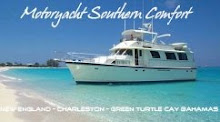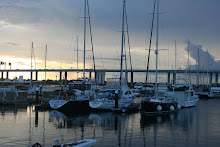
Calving season for the massive, endangered species begins in mid-November and runs through mid-April.
Marine biologists will begin aerial watches of the animals December 1st in Georgia and November 15 in South Carolina.
There are only an estimated 300 to 400 right whales left in the wild and about half of those migrate to the warmer waters off the coasts of Georgia and Florida each winter to give birth to calves.

Hitting a Right Whale is easier than you think. Three years ago Captain James Tawney was part of a crew delivering an owner's Eastbay Express to Florida. It was bright sunny day with seas running 1-2 feet, just easy swells and light wind. There had not been any reports of Right Whales in the area, for weeks, but early in the afternoon with the sun in their eyes the boat named Blue Heron suddenly lifted and came to a jolting and abrupt stop.
Both crew members were knocked to the deck and amazed to find a massive North Atlantic Right Whale later identified as the 11 year old whale no. 2425, with a smaller whale only a few feet from the boat.
The damage to the boat's rudders and props was extensive, injury to the whale was pretty substantial but not immediately life threatening. The crew called the Coast Guard who instructed them to divert to Amelia Island Yacht Basin.
The vessel limped into port, and spent the next 24 hours dealing with interviews, and paper work. Divers determined the damage to be extensive enough to require the yacht to hauled out of the water until repairs could be made.

The above image shows the wounds caused by the port propeller and rudder. Photo By: Thomas D. Pitchford Florida Fish and Wildlife Conservation Commission Fish and Wildlife Research Institute.

Gashes from the Eastbay's prop are clearly visible in this March 10, 2005 Photo New England Aquarium.

Right Whale 2425 September 3, 2005, with the left tail fin completly severed. This was the last reported sighting of Right Whale No. 2425 Photo New England Aquarium.

NOAA and its rescue team partners off the South Carolina coast working to free a young endangered right whale entangled in ropes and buoys. The team successfully removed all of the ropes and gear from the whale's body. Photo by Alicia Windham-Reid.
The Georgia and South Carolina DNR is asking boaters to slow down and keep a vigilant watch on the water during the vital calving season.
By law, boaters must remain 500 yards away from whales.
Vessels should reduce speed to 10 knots or slower when in calving grounds and slow down to a minimal speed when a whale is spotted in open water.
Take extreme caution in times of low visibility, such as in foggy conditions and at night, when spotting whales is more difficult.
Wearing polarized sunglasses makes seeing the whales easier.
In recent years, boaters have gotten the message about taking precautions in calving season. Fewer reports of ships striking whales are being made.
During the 2007-2008 calving season, no dead calves were found on Georgia shores, although a few were found in Florida.
The main message is, just slow down and be careful. Look for those big gray spots in the water and avoid them.
Knowing what to watch for in open waters can help boaters avoid hitting right whales.
One thing for Southeastern boaters to remember is that North Atlantic Right Whales do not have dorsal fins, which can the 40 to 50 feet long whale harder to see from surface waters.
So remember you are not looking for a "Free Willy" Orca with a dorsal fin, simply a grey shape in the shallow waters off the Carolina Coast.




Thanks for reminding folks that even a recreational boat can hit and seriously injure a whale. I was on the water the day the Eastbay struck the whale and I commend the Captain and crew for reporting the strike and standing by the whale so assessment teams could determine the identity of the whale, document its injuries, and learn the circumstances of the collision. If only more Captains would do the same. Much can be learned about vessel strikes when the vessel operator can be interviewed and we all hear what was seen, felt, and heard. Additionally, the specifics of this vessel (length, speed, prop diameter and pitch, etc.) are known and can be compared to the wounds observed on this animal. Ultimately, this information helps to better understand all vessel strikes.
ReplyDeleteIf you would like a picture of the injured whale, email me at: floridawhales@gmail.com